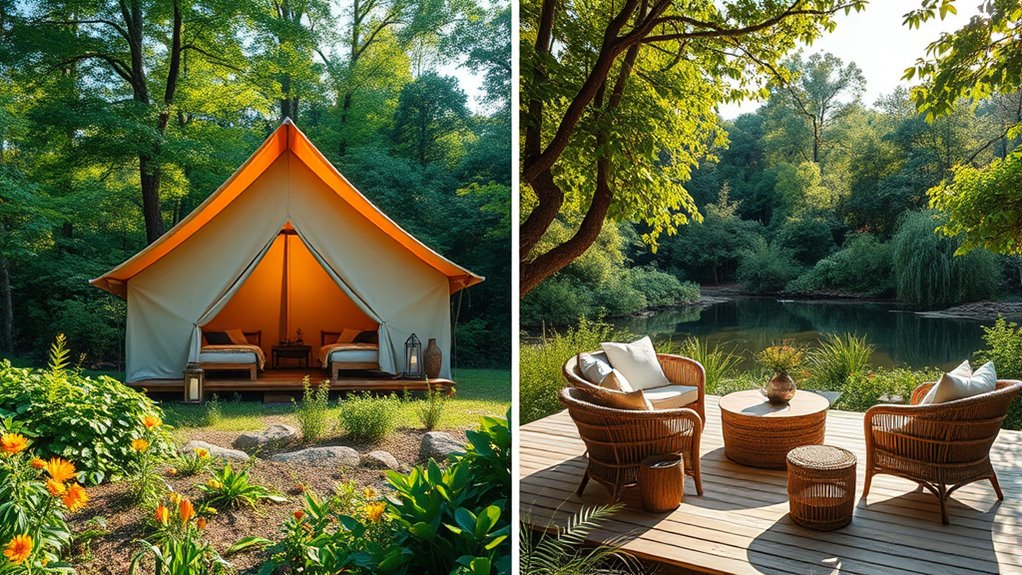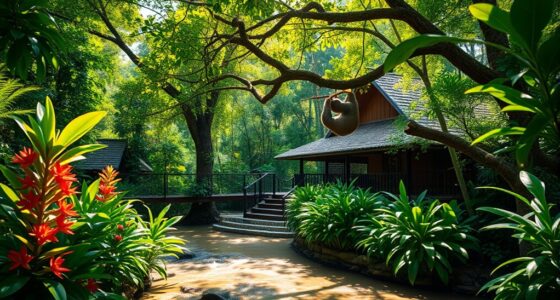Green glamping combines eco-friendly luxury camping with sustainable practices that protect the environment and enhance your experience. It uses renewable energy, eco-conscious materials, water-saving techniques, and waste management to reduce your carbon footprint. You can enjoy nature, culture, and biodiversity while supporting responsible tourism. With a focus on minimal ecological impact and maximum comfort, this innovative approach offers a unique way to connect with nature. Keep exploring to discover how these sustainable retreats make your stay both luxurious and eco-conscious.
Key Takeaways
- Combines luxury accommodations with eco-friendly practices like renewable energy, sustainable materials, and waste management to minimize environmental impact.
- Uses natural and biodegradable building materials such as reclaimed wood, bamboo, and natural stones for sustainable structures.
- Implements water conservation through rainwater harvesting, low-flow fixtures, and greywater recycling, promoting resource efficiency.
- Offers immersive experiences connecting guests with local cultures, wildlife, and biodiversity through guided activities and eco-conscious design.
- Growing market trend driven by eco-conscious travelers seeking luxurious, responsible outdoor experiences with minimal ecological footprints.
Defining the Concept of Green Glamping
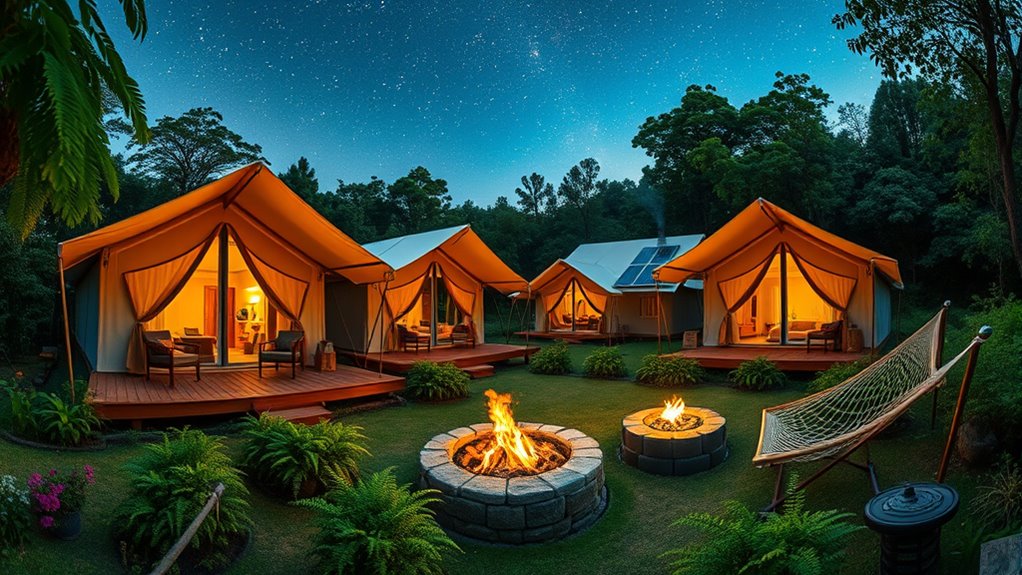
Green glamping combines the luxury of high-end accommodations with a deep commitment to environmental sustainability. It’s about offering guests a comfortable experience while respecting nature and local cultures. As you stay in eco-friendly tents, yurts, or treehouses, you enjoy amenities like electricity, Wi-Fi, and private bathrooms, all designed to minimize environmental impact. This approach promotes wildlife conservation by reducing habitat disturbance and supporting responsible land use through sustainable infrastructure. It also fosters cultural immersion, allowing you to connect authentically with local communities, traditions, and ecosystems. Green glamping exemplifies responsible travel, blending luxury with eco-conscious practices such as renewable energy and responsible waste management. It’s a purposeful way to enjoy nature, ensuring your experience benefits both the environment and local cultures. It also encourages sustainable tourism practices that can positively influence local economies and ecosystems.
Sustainable Materials and Eco-Friendly Structures

Choosing sustainable materials and eco-friendly structures is essential for creating responsible luxury camping experiences. You can use biodegradable products like thatched roofs made from straw or palm fronds, which naturally insulate and are locally sourced. Reclaimed wood and recycled plastic composite blocks transform waste into durable, eco-friendly building materials, earning green certifications for their sustainability. Natural stones sourced nearby help regulate temperature passively, reducing energy needs. Here’s a vivid image:
| Material Type | Benefits |
|---|---|
| Bamboo | Fast-growing, minimal water, reduces deforestation |
| Straw bale | Excellent insulation, biodegradable |
| Reclaimed wood | Reduces demand, preserves forests |
| Natural stones | Thermal regulation, local sourcing |
Environmental impact reduction is further supported by selecting materials that promote energy efficiency and low carbon footprints throughout their lifecycle, emphasizing the importance of sustainable construction practices.
Renewable Energy Solutions for Luxury Camping
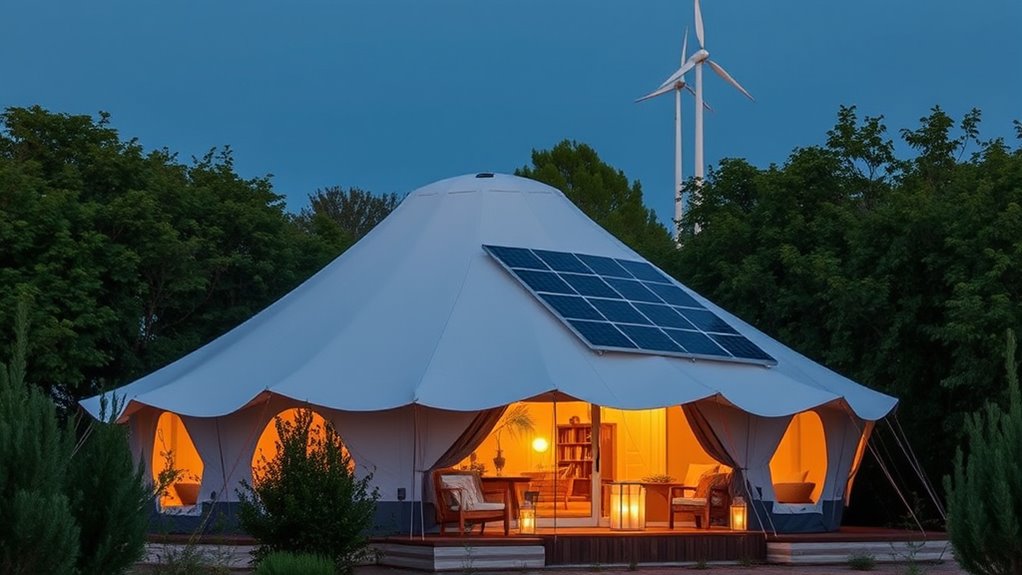
Integrating renewable energy solutions into luxury camping enhances sustainability while maintaining high-end comfort. Solar integration with photovoltaic panels allows your site to operate off-grid, powering lighting, water heating, and entertainment. Portable solar stations offer flexibility and backup power, ensuring uninterrupted luxury experiences. Wind turbines, when placed in windy locations, can generate substantial off-grid electricity, reducing reliance on fossil fuels and lowering operational costs. Hybrid systems combining solar and wind optimize energy use and reliability. These technologies operate silently and discreetly, preserving the natural ambiance your guests cherish. Additionally, understanding the weight of wind turbine blades can inform the planning and logistics of installing wind energy systems in your site. By harnessing renewable energy, you create an eco-friendly retreat that balances opulence with environmental responsibility.
- Feel the freedom of off-grid independence
- Enjoy quiet, unobtrusive energy solutions
- Reduce your carbon footprint effortlessly
- Provide guests with sustainable luxury
- Create a truly harmonious outdoor experience
Water Conservation and Waste Management Practices

Harnessing renewable energy is a significant step toward sustainable luxury camping, but managing water resources effectively is equally essential. You can achieve this through water conservation and waste management practices that protect the environment. Rainwater harvesting supplies water for irrigation and toilets, reducing reliance on fresh water. Installing low-flow fixtures and greywater recycling systems further cuts water use, saving costs and preserving resources. Educating guests encourages responsible habits like towel reuse and mindful consumption. Waste management strategies, such as composting toilets and eco-friendly cleaning, prevent pollution. Proper waste disposal and waste stream segregation support water quality. Regular monitoring ensures adaptive water management. Implementing recycling and composting programs can significantly reduce waste and promote sustainability on-site.
Enhancing Guest Comfort With Eco-Conscious Amenities
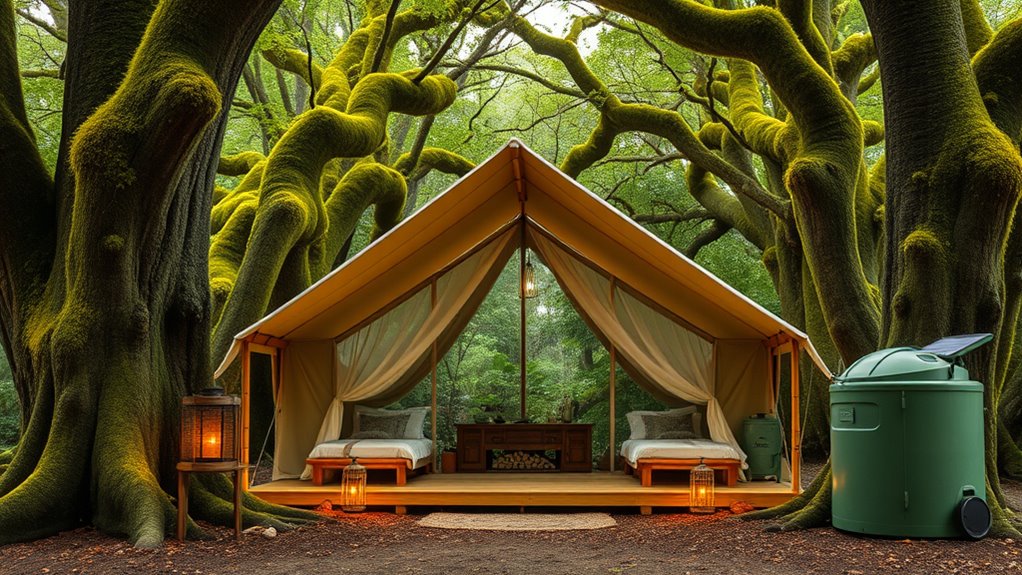
You can enjoy comfort without compromising sustainability by choosing eco-friendly bedding made from organic cotton, bamboo, or hemp. Energy-efficient systems powered by solar or wind keep your space cozy while reducing environmental impact. Plus, natural materials and biodegradable amenities make your stay both luxurious and eco-conscious. Moreover, many glamping sites now incorporate renewable energy sources to further minimize their carbon footprint. Incorporating sustainable design principles can also enhance the overall eco-friendliness of your glamping experience.
Sustainable Comfort Features
Eco-friendly luxury camping focuses on providing guests with comfort while reducing environmental impact through thoughtful amenities. You’ll enjoy climate-responsive features like natural ventilation, thermal mass, and smart controls that keep your stay cozy without excess energy use. Renewable energy sources, such as solar panels and wind turbines, power your accommodations while supporting wildlife preservation and carbon offsetting efforts. Water conservation is seamlessly integrated with rainwater harvesting, low-flow fixtures, and composting toilets, ensuring comfort without waste. Sustainable materials like reclaimed wood and bamboo enhance durability and harmony with nature. You’ll also benefit from eco-conscious waste management, including composting and recycling programs, creating a responsible, luxurious experience that minimizes your footprint. Incorporating projector technology into your campsite can enhance entertainment options while maintaining energy efficiency and reducing environmental impact.
Eco-Friendly Luxury Amenities
Eco-conscious amenities elevate the luxury camping experience by seamlessly blending comfort with sustainability. You can enjoy solar-powered facilities that reduce reliance on fossil fuels, while composting toilets minimize water use and waste. Organic, biodegradable toiletries help lower environmental impact, and rainwater harvesting systems conserve water for non-potable needs. Native plant landscaping supports wildlife conservation and boosts biodiversity, creating a natural, vibrant setting. Many sites feature amenities like outdoor hot tubs and fire pits powered by sustainable energy, along with outdoor kitchens showcasing locally sourced ingredients. Supporting local artisans through handcrafted furnishings and decor adds an authentic touch. These eco-friendly amenities guarantee your comfort while actively protecting the environment and celebrating the community’s craftsmanship, making your glamping experience both luxurious and responsible. Sustainable energy sources also contribute to reducing the overall carbon footprint of the glampsite. Additionally, incorporating environmentally friendly practices ensures that the site maintains its sustainability standards and minimizes its ecological impact.
Connecting Guests With Nature and Local Cultures
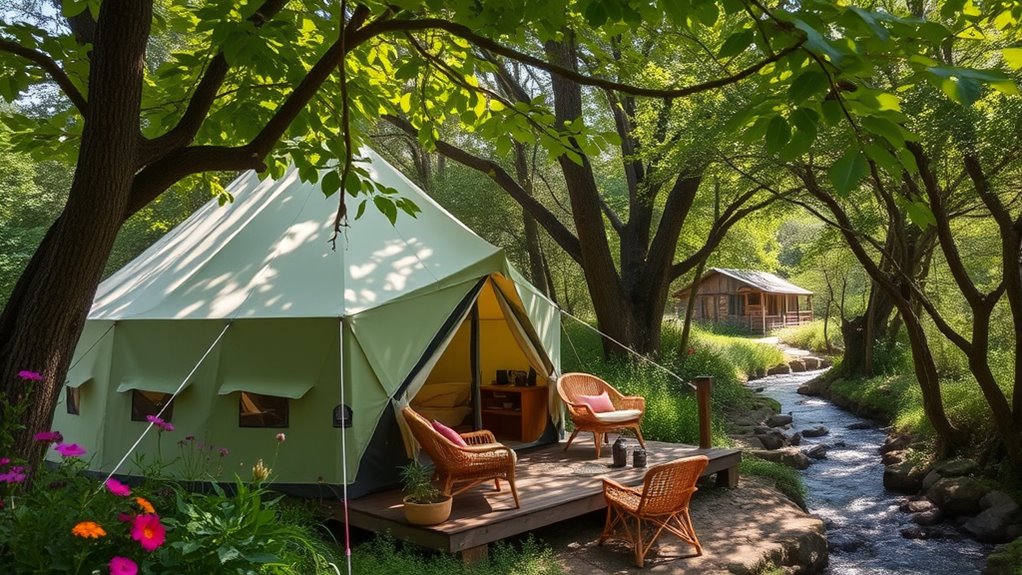
Connecting with nature and local cultures is at the heart of luxurious glamping experiences, offering you a deeper sense of immersion beyond traditional accommodations. You’ll find yourself surrounded by vibrant wildlife habitats, fostering a genuine connection to the land. Many sites integrate local artisans and traditions, supporting cultural preservation and giving you authentic experiences. You might participate in guided nature walks, wildlife watching, or star gazing, heightening your sensory engagement. These activities promote mindfulness and emotional bonds with the environment. Imagine:
- Listening to indigenous stories around a campfire
- Learning traditional crafts from local artisans
- Exploring native flora and fauna firsthand
- Supporting local farms through farm-to-table meals
- Celebrating regional festivals and customs
These elements deepen your understanding of the land and its people, enriching your glamping journey. Additionally, incorporating mindfulness techniques during your experience can enhance your emotional connection and overall sense of well-being.
The Environmental Advantages Over Traditional Camping
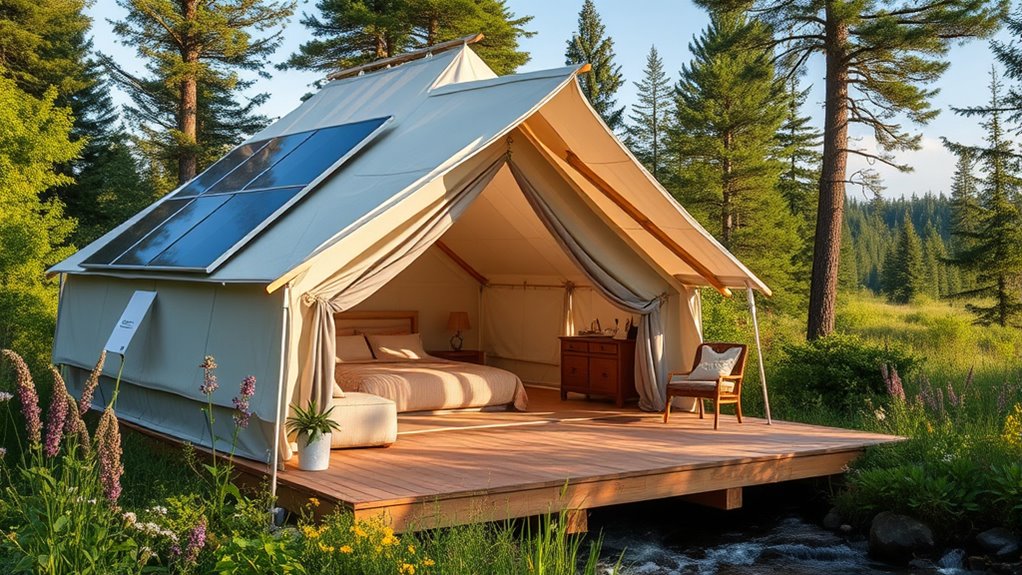
Choosing glamping over traditional camping substantially reduces your environmental impact. It minimizes resource use, relying on renewable energy like solar and wind, and sustainable materials such as recycled wood and bamboo. This approach preserves soil and vegetation by requiring less land disturbance and implementing water-saving practices like rainwater harvesting. Waste management is eco-friendly, with composting toilets, biodegradable products, and recycling efforts, preventing soil and water contamination. Glamping sites are designed to protect wildlife corridors and native habitats, limiting noise, open fires, and trampling. These measures help conserve local flora and fauna, ensuring cultural preservation of the area. Overall, glamping offers a luxurious experience that actively supports environmental health and the protection of delicate ecosystems compared to traditional camping methods. Incorporating sound mixing techniques ensures the experience remains peaceful and minimally disruptive to the natural surroundings.
Market Growth and Trends in Eco-Luxury Camping

The eco-luxury camping market is experiencing rapid expansion, driven by increasing consumer demand for sustainable, high-end outdoor experiences. As you seek immersive adventures, you’re drawn to sites that showcase the Night Sky’s brilliance and offer Wildlife Observation in pristine settings. The market is projected to grow markedly, with estimates reaching USD 9.3 billion by 2033. You’ll find: – Luxurious tents, cabins, and treehouses blending comfort with nature – Unique experiences near national and state parks – Off-grid energy solutions for eco-conscious travelers – Tech-savvy amenities like Wi-Fi and climate control – Growing popularity of treehouse glamping for seclusion and sustainability This trend caters to millennials and Gen Z, fueling a vibrant, innovative market where luxury meets environmental stewardship, all while enjoying breathtaking views of the night sky and observing wildlife in their natural habitat. Sustainable tourism is increasingly influencing consumer choices and shaping the future of eco-luxury camping.
Challenges and Opportunities in Green Glamping Development

Developing green glamping sites presents both significant opportunities and pressing challenges. You can promote wildlife preservation by designing eco-friendly accommodations that blend seamlessly with nature. However, balancing development with cultural integration can be tricky; respecting local traditions is key to social harmony. Environmental impact assessments and land use planning help minimize ecological disruption but require careful navigation of zoning and regulations. Technological integration, like smart accommodations, enhances guest experiences but demands high initial investments. The table below highlights core considerations: diverse designs and the importance of aligning aesthetic choices with sustainability goals.
How to Choose a Sustainable and Luxurious Glamping Site
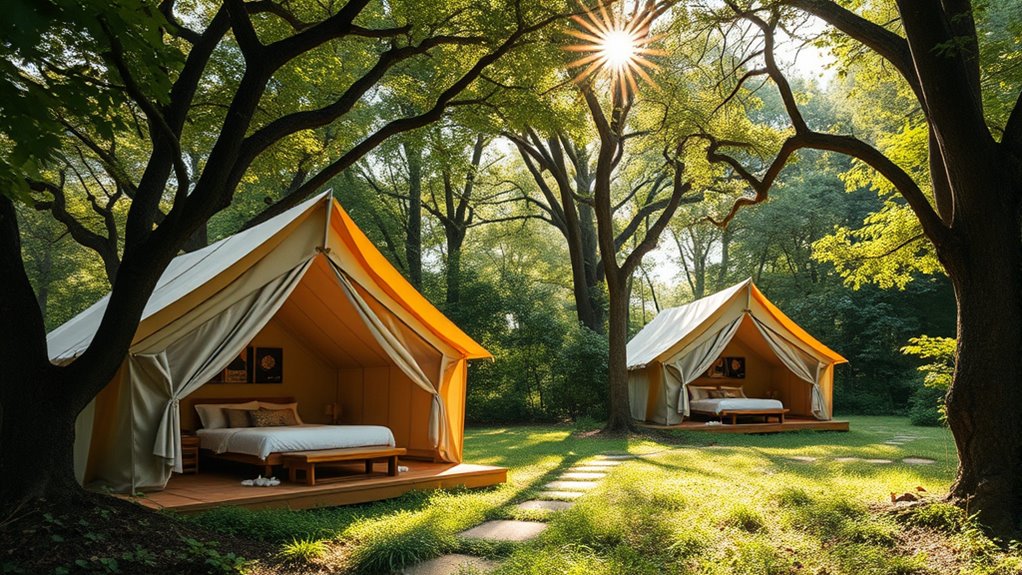
When selecting a glamping site, focus on locations that use eco-friendly construction materials like reclaimed wood or bamboo, reducing environmental impact. Look for sites that incorporate renewable energy features, such as solar panels or wind turbines, to guarantee a sustainable power supply. By prioritizing these factors, you can enjoy luxury while minimizing your ecological footprint. Establishing healthy boundaries with the site management can further enhance your experience and ensure your needs are respected.
Eco-Friendly Construction Materials
Choosing eco-friendly construction materials for a luxurious glamping site involves prioritizing durability, sustainability, and aesthetic appeal. You’ll want innovative insulation like hempcrete, which offers thermal comfort while being carbon-negative and biodegradable. For surfaces and furnishings, eco-friendly options such as reclaimed wood, bamboo, and cork bring natural beauty and reduce environmental impact. Consider using high-tensile canvas for breathable walls and natural fire-resistant fabrics for safety. Incorporate recycled plastics in outdoor furniture or decking to minimize waste, and opt for prefabricated, modular construction methods to reduce onsite disruption.
- Feel the warmth of natural hempcrete insulating your space
- Admire stunning reclaimed wood accents
- Experience comfort with eco friendly furnishings
- Enjoy the durability of composite decking
- Connect to nature through bamboo and cork finishes
Renewable Energy Features
Integrating renewable energy solutions elevates a luxury glamping site by blending eco-consciousness with comfort and style. Solar integration allows you to harness sunlight, powering lighting, heating, and appliances silently, while portable solar stations provide backup in remote locations. Combining solar with wind hybrid systems maximizes energy reliability, especially in windy areas, reducing dependence on the grid and fossil fuels. These hybrid setups are scalable, enabling incremental expansion as your needs grow. Smart energy management systems optimize consumption by automatically adjusting to weather conditions and guest demands, enhancing efficiency and guest comfort. Incorporating renewable energy features like solar and wind hybrid not only minimizes environmental impact but also demonstrates a commitment to sustainability, which can be a significant selling point for eco-conscious travelers.
Frequently Asked Questions
How Does Green Glamping Impact Local Ecosystems?
You might wonder how green glamping impacts local ecosystems. When done responsibly, it promotes biodiversity preservation by using existing sites and native plants, reducing habitat disruption. Green glamping minimizes land disturbance, supports local flora and fauna, and encourages sustainable practices like waste management and renewable energy. By focusing on habitat preservation and eco-friendly operations, it helps protect ecosystems instead of harming them, fostering a healthier environment for wildlife and communities.
Are Green Glamping Facilities More Expensive Than Traditional Campsites?
You might think all camping costs are the same, but the cost comparison shows green glamping is pricier. Luxury pricing for eco-friendly sites can be up to 200% higher than traditional campsites, mainly because of upscale amenities and sustainable infrastructure. While traditional camping has lower upfront and nightly costs, glamping offers comfort and eco-conscious luxury, justifying the higher prices for those seeking convenience and a touch of luxury in nature.
What Certifications Verify Eco-Friendly Practices in Green Glamping?
You want to know which certifications verify eco-friendly practices. Eco labels like Eco-Certified Campgrounds, Green Key, and Green Globe guarantee facilities meet strict certification standards. These standards focus on sustainable waste management, water conservation, energy efficiency, and responsible operations. By earning these certifications, your glamping site proves its commitment to sustainability, attracts eco-conscious guests, and adheres to rigorous certification standards that promote environmental responsibility worldwide.
How Do Green Glamping Sites Ensure Guest Safety With Sustainable Materials?
You guarantee guest safety by choosing eco-friendly insulation that maintains comfortable indoor temperatures without harmful chemicals. Using non-toxic furnishings reduces health risks from toxic emissions and enhances overall safety. Sustainable building materials like bamboo and reclaimed wood are durable and safe, while renewable energy sources like solar panels minimize fire hazards. These practices create a safe, healthy environment, proving that eco-conscious choices can go hand-in-hand with guest well-being.
Can Green Glamping Accommodate Travelers With Special Accessibility Needs?
Imagine you’re stepping into a world where accessibility meets nature’s beauty. Green glamping can indeed cater to travelers with special needs by offering accessible accommodations and adaptive features. Many sites now incorporate ramps, wide pathways, and user-friendly facilities, making it easier for everyone to enjoy the outdoors. While some eco-friendly designs pose challenges, thoughtful planning ensures inclusivity, creating memorable experiences for all guests while respecting the environment.
Conclusion
Green glamping is like a gust of fresh air, blending luxury with sustainability effortlessly. By choosing eco-friendly materials, renewable energy, and water-saving practices, you not only enjoy comfort but also protect the planet. As this trend grows, it offers a bright future for responsible travelers. Embrace green glamping and turn your getaway into an adventure that’s as enriching as it is indulgent—your perfect escape that cares for the Earth.
